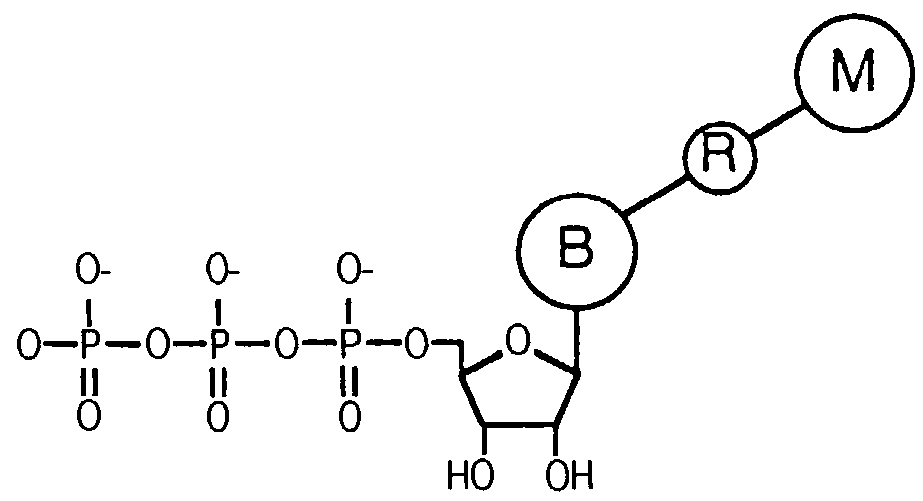Releasable nonvolatile mass-label molecules
a nonvolatile, mass-label technology, applied in the field of chemical analysis, can solve the problems of limiting the extent of multiplexing, providing a more complex analysis requirement, interfering with detection, etc., and achieve the effect of increasing detection signal and reducing background
- Summary
- Abstract
- Description
- Claims
- Application Information
AI Technical Summary
Benefits of technology
Problems solved by technology
Method used
Image
Examples
example 1
Synthesis of Peptide-Labeled Oligonucleotides
A. Preparation of Peptide-Linked Nucleoside 5′ Triphosphates
[0278]Preparation of peptide-linked nucleoside 5′-triphosphates involves synthesis and coupling of allylamino-substituted dNTPs. An example is shown in FIG. 6A. 5-(3-aminoallyl)-2′-deoxyuridine 5′-triphosphate (c) was prepared according to the procedure of Langer et al., 1981). Treatment of dUTP (a) with mercuric acetate at pH 5–7 provides the 5-mercurated derivative (b). Allylation in the presence of a palladium catalyst then provided c, which was coupled to the NHS-ester (d) of a suitably protected peptide (lysine and N-terminal amines blocked with FMOC groups). Base deprotection of the peptide resulted in formation of the desired product (e). Alternatively, the allylamino-nucleotide (c) was treated sequentially with the hetero-bifunctional crosslinking reagent mal-sac-HNSA (Bachem Bioscience Inc., King of Prussia, Pa.) and an N-terminal cysteine peptide to give the conjugate (...
example 2
Detection of a Specific Target Sequence
[0283]As an example of the utility of the oligonucleotide-peptide conjugate as a probe in a hybridization study, a model system was designed using a synthetic complementary strand as target DNA. A 42-mer was synthesized as a model target, with the sequence 5′-CTCCCAGGACAGGCACAAACACGCACCTCAAAGCTGTTCCGT-3′ (SEQ ID NO: 3). Detection of the target was based on release of the peptide mass label (SEQ ID NO: 2) from the probe by a digestion with the 3′-5′ double-strand-specific exonuclease III with analysis by MALDI-MS.
[0284]A mixture of 1 pmol of probe and 1 pmol of target in a 9 μL volume of 1× Exonuclease III buffer (66 mM Tris-HC1, pH 8.0; 5 mM DTT; 6.6 mM MgCl2; 50 μg / mL BSA) was allowed to anneal by heating the solution for 2 minutes in a boiling water bath and then slowly cooling it to room temperature over the course of about 20 minutes. Exonuclease III (USB, Cleveland, Ohio) was diluted from its stock concentration of 17.5 U / μL in 1×buffer, a...
example 3
Detection of MRNA using Mass-Labeled Primers and rtPCR™
[0286]A pair of PCR™ primers for the ribosomal protein L7 gene was synthesized by standard phosphoramidite chemistry with a modified amino-thymidine (Glen Research, Sterlin, Va.) incorporated near the 3′-end of each. The sequence of the forward primer was 5′-ATCTGAAGTCAGTAAATGAAC-3′ (SEQ ID NO: 4) and the sequence for the reverse primer was 5′-ATTTACCAGAGATCGAG-3′ (SEQ ID NO: 5), where T* represents the amino-modified thymidine. Each primer was mass-labeled with a unique peptide by a standard coupling reaction between the amino group of the amino-modified thymidine and a sulfhydryl group on the peptide through the heterobifunctional linker mal-SAC-HNSA (Bachem Corp., Torrance, Claif.), and purified by ion-exchange HPLC. The peptide mass label used for the forward primer had the sequence CGYGPKKKRKVGG (SEQ ID NO: 2), and for the reverse primer the peptide was CKNLNKDKQVYRATHR (SEQ ID NO: 6).
[0287]A reverse transcription reaction ...
PUM
| Property | Measurement | Unit |
|---|---|---|
| Mass | aaaaa | aaaaa |
| Mass | aaaaa | aaaaa |
| Molecular weight | aaaaa | aaaaa |
Abstract
Description
Claims
Application Information
 Login to View More
Login to View More - R&D
- Intellectual Property
- Life Sciences
- Materials
- Tech Scout
- Unparalleled Data Quality
- Higher Quality Content
- 60% Fewer Hallucinations
Browse by: Latest US Patents, China's latest patents, Technical Efficacy Thesaurus, Application Domain, Technology Topic, Popular Technical Reports.
© 2025 PatSnap. All rights reserved.Legal|Privacy policy|Modern Slavery Act Transparency Statement|Sitemap|About US| Contact US: help@patsnap.com



